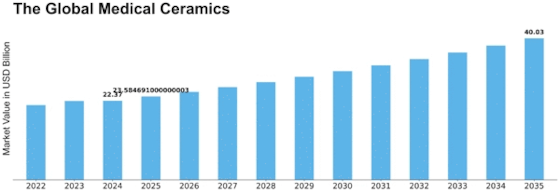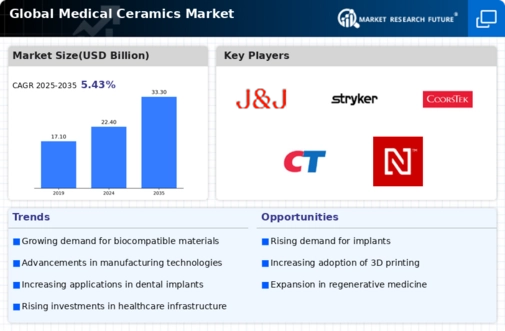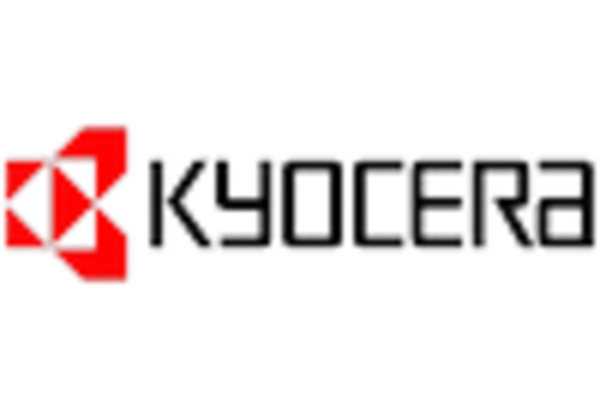-
EXECUTIVE SUMMARY
-
MARKET INTRODUCTION
-
DEFINITION 17
-
2.2
-
SCOPE OF THE STUDY 17
-
RESEARCH OBJECTIVE 17
-
MARKET STRUCTURE 17
-
ASSUMPTIONS & LIMITATIONS 18
-
RESEARCH METHODOLOGY
-
DATA
-
MINING 19
-
SECONDARY RESEARCH 20
-
PRIMARY RESEARCH 21
-
BREAKDOWN
-
OF PRIMARY RESPONDENTS 22
-
FORECASTING TECHNIQUES 22
-
RESEARCH METHODOLOGY
- BOTTOM-UP APPROACH 25
- TOP-DOWN
-
FOR MARKET SIZE ESTIMATION 24
-
APPROACH 25
-
DATA TRIANGULATION 26
-
VALIDATION 26
-
MARKET
-
DYNAMICS
-
OVERVIEW 27
-
DRIVERS 28
- INCREASING NUMBER OF
- GROWING GERIATRIC POPULATION
- RAPID INFLUX OF NOVEL PRODUCT VARIETIES AND
- FAVORABLE GOVERNMENT
-
MEDICAL PROCEDURES USING MEDICAL CERAMICS 28
-
PRONE TO CHRONIC ILLNESS 28
-
TECHNOLOGICAL ADVANCEMENTS IN MEDICAL CERAMICS 29
-
INITIATIVES AND RISING NUMBER OF CLINICAL TRIALS 29
-
RESTRAINT 31
-
4.3.1
-
POTENTIALLY HARMFUL EFFECTS OF MEDICAL CERAMICS 31
-
OPPORTUNITY 31
-
4.4.1
-
COLLABORATIONS WITH SMALL MARKET PLAYERS 31
-
MARKET FACTOR ANALYSIS
-
5.1
-
SUPPLY CHAIN ANALYSIS 32
-
33
-
5.3
-
COVID-19 IMPACT ANALYSIS 36
-
SUPPLY CHAIN 36
-
R&D AND DESIGNING 33
-
MANUFACTURING
-
DISTRIBUTION & SALES 33
-
POST-SALES MONITORING 33
-
PORTER’S FIVE FORCES MODEL 34
- THREAT OF NEW ENTRANTS 34
- BARGAINING POWER OF SUPPLIERS 35
- THREAT OF SUBSTITUTES 35
- BARGAINING POWER OF BUYERS 35
- INTENSITY OF RIVALRY 35
- IMPACT ON R&D 36
- IMPACT ON
- IMPACT ON MANUFACTURERS 37
-
GLOBAL MEDICAL CERAMICS
-
MARKET, BY TYPE
-
OVERVIEW 38
-
BIOINERT CERAMICS 39
-
BIOACTIVE
-
CERAMICS 40
-
BIORESORBABLE CERAMICS 41
-
PIEZOCERAMICS 41
-
7
-
GLOBAL MEDICAL CERAMICS MARKET, BY APPLICATION
-
OVERVIEW 42
-
DENTAL
-
APPLICATIONS 43
-
ORTHOPEDIC APPLICATIONS 44
-
CARDIOVASCULAR 45
-
MEDICAL DEVICES 45
-
PLASTIC SURGERY 46
-
GLOBAL MEDICAL CERAMICS
-
MARKET, BY END USER
-
OVERVIEW 47
-
HOSPITALS & CLINICS 48
-
SPECIALTY CENTERS 48
-
GLOBAL MEDICAL CERAMICS MARKET, BY REGION
-
9.1
-
OVERVIEW 49
-
AMERICAS 50
- NORTH AMERICA 53
- LATIN AMERICA 61
-
EUROPE 64
- WESTERN
-
EUROPE 67
-
9.3.1.4
-
ITALY 78
-
9.3.2
-
EASTERN EUROPE 85
-
ASIA-PACIFIC 88
- CHINA 91
- JAPAN
- INDIA 96
- AUSTRALIA 99
- SOUTH KOREA 101
-
94
-
9.4.6
-
REST OF ASIA-PACIFIC 104
-
MIDDLE EAST & AFRICA 107
- MIDDLE
- AFRICA 113
-
EAST 110
-
COMPETITIVE LANDSCAPE
-
OVERVIEW
-
116
-
COMPETITIVE BENCHMARKING 117
-
COMPETITOR DASHBOARD 118
-
MAJOR GROWTH STRATEGY IN THE GLOBAL MEDICAL CERAMICS MARKET 118
-
10.5
-
THE LEADING PLAYER IN TERMS OF NUMBER OF DEVELOPMENTS IN THE GLOBAL MEDICAL CERAMICS
-
MARKET 119
-
KEY DEVELOPMENT ANALYSIS 119
-
KEY DEVELOPMENTS &
- PRODUCT LAUNCHES/PRODUCT APPROVALS 120
- PARTNERSHIPS/AGREEMENTS/JOINT VENTURES 121
- EXPANSIONS 122
-
GROWTH STRATEGIES 120
-
10.7.2
-
MERGERS/ACQUISITIONS 121
-
COMPANY PROFILES
-
ZIMMER BIOMET HOLDINGS
- COMPANY OVERVIEWS 123
- FINANCIAL OVERVIEW 124
- PRODUCTS/SERVICES OFFERED 124
- KEY DEVELOPMENTS 125
- KEY STRATEGIES 126
-
INC. 123
-
11.1.5
-
SWOT ANALYSIS 125
-
INSTITUT STRAUMANN AG
- COMPANY OVERVIEW 127
- FINANCIAL OVERVIEW 128
- KEY DEVELOPMENTS 129
- SWOT
- KEY STRATEGIES 130
-
127
-
11.2.3
-
PRODUCTS/SERVICES OFFERED 129
-
ANALYSIS 130
-
3M 131
- COMPANY
- FINANCIAL OVERVIEW 132
- PRODUCTS/SERVICES OFFERED
- KEY DEVELOPMENTS 133
- SWOT ANALYSIS 133
- KEY
-
OVERVIEW 131
-
132
-
STRATEGIES 133
-
DEPUY SYNTHES 134
- COMPANY OVERVIEW 134
- PRODUCTS/SERVICES OFFERED 135
- KEY
- SWOT ANALYSIS 136
- KEY STRATEGIES 136
-
11.4.2
-
FINANCIAL OVERVIEW 135
-
DEVELOPMENTS 136
-
STRYKER 137
- COMPANY OVERVIEW 137
- FINANCIAL OVERVIEW
- PRODUCTS/SERVICES OFFERED 138
- KEY DEVELOPMENTS 139
- SWOT ANALYSIS 139
- KEY STRATEGIES 139
-
138
-
COORSTEK INC.
- COMPANY OVERVIEW 140
- FINANCIAL OVERVIEW 140
- KEY DEVELOPMENTS 141
- SWOT
- KEY STRATEGIES 142
-
140
-
11.6.3
-
PRODUCTS/SERVICES OFFERED 140
-
ANALYSIS 141
-
CERAMTEC 143
- COMPANY
- FINANCIAL OVERVIEW 144
- PRODUCTS/SERVICES OFFERED
- KEY DEVELOPMENTS 145
- SWOT ANALYSIS 146
- KEY
-
OVERVIEW 143
-
145
-
STRATEGIES 146
-
NOBEL BIOCARE HOLDING AG 147
- COMPANY OVERVIEW
- FINANCIAL OVERVIEW 148
- PRODUCTS/SERVICES OFFERED 148
- KEY DEVELOPMENTS 149
- SWOT ANALYSIS 149
- KEY STRATEGIES
-
147
-
149
-
KYOCERA CORPORATION 150
- COMPANY OVERVIEWS 150
- PRODUCTS/SERVICES OFFERED 151
- KEY
- SWOT ANALYSIS 152
- KEY STRATEGIES 152
-
11.9.2
-
FINANCIAL OVERVIEW 150
-
DEVELOPMENTS 151
-
RAUSCHERT GROUP 153
- COMPANY OVERVIEW 153
- FINANCIAL
- PRODUCTS/SERVICES OFFERED 153
- KEY DEVELOPMENTS
- SWOT ANALYSIS 154
- KEY STRATEGIES 154
-
OVERVIEW 153
-
153
-
APPENDIX
-
REFERENCES 155
-
RELATED REPORTS 155
-
LIST OF TABLES
-
LIST OF ASSUMPTIONS & LIMITATIONS 18
-
PRIMARY INTERVIEWS
-
AND INFORMATION GATHERING PROCESS 21
-
GLOBAL MEDICAL CERAMICS MARKET,
-
BY TYPE, 2023-2030 (USD MILLION) 38
-
GLOBAL MEDICAL CERAMICS MARKET,
-
FOR BIOINERT CERAMICS, BY REGION, 2023-2030 (USD MILLION) 39
-
GLOBAL
-
MEDICAL CERAMICS MARKET, FOR BIOINERT CERAMICS, BY TYPE, 2023-2030 (USD MILLION)
-
39
-
GLOBAL MEDICAL CERAMICS MARKET, FOR BIOACTIVE CERAMICS, BY REGION,
-
GLOBAL MEDICAL CERAMICS MARKET, FOR BIOACTIVE
-
CERAMICS, BY TYPE, 2023-2030 (USD MILLION) 40
-
GLOBAL MEDICAL CERAMICS
-
MARKET, FOR BIORESORBABLE CERAMICS, BY REGION, 2023-2030 (USD MILLION) 41
-
TABLE
-
GLOBAL MEDICAL CERAMICS MARKET, FOR PIEZOCERAMICS, BY REGION, 2023-2030 (USD MILLION)
-
41
-
GLOBAL MEDICAL CERAMICS MARKET, BY APPLICATION, 2023-2030 (USD
-
MILLION) 42
-
GLOBAL MEDICAL CERAMICS MARKET, FOR DENTAL APPLICATIONS,
-
BY REGION, 2023-2030 (USD MILLION) 43
-
GLOBAL MEDICAL CERAMICS MARKET,
-
FOR DENTAL APPLICATIONS, BY TYPE, 2023-2030 (USD MILLION) 43
-
GLOBAL
-
MEDICAL CERAMICS MARKET, FOR ORTHOPEDIC APPLICATIONS, BY REGION, 2023-2030 (USD
-
MILLION) 44
-
GLOBAL MEDICAL CERAMICS MARKET, FOR ORTHOPEDIC APPLICATIONS,
-
BY TYPE, 2023-2030 (USD MILLION) 44
-
GLOBAL MEDICAL CERAMICS MARKET,
-
FOR CARDIOVASCULAR, BY REGION, 2023-2030 (USD MILLION) 45
-
GLOBAL MEDICAL
-
CERAMICS MARKET, FOR MEDICAL DEVICES, BY REGION, 2023-2030 (USD MILLION) 45
-
TABLE
-
GLOBAL MEDICAL CERAMICS MARKET, FOR PLASTIC SURGERY, BY REGION, 2023-2030 (USD
-
MILLION) 46
-
GLOBAL MEDICAL CERAMICS MARKET, BY END USER, 2023-2030
-
(USD MILLION) 48
-
GLOBAL MEDICAL CERAMICS MARKET, FOR HOSPITALS &
-
CLINICS, BY REGION, 2023-2030 (USD MILLION) 48
-
GLOBAL MEDICAL CERAMICS
-
MARKET, FOR SPECIALTY CENTERS, BY REGION, 2023-2030 (USD MILLION) 48
-
TABLE
-
GLOBAL MEDICAL CERAMICS MARKET, BY REGION, 2023-2030 (USD MILLION) 49
-
TABLE
-
AMERICAS: MEDICAL CERAMICS MARKET, BY REGION, 2023-2030 (USD MILLION) 50
-
TABLE
-
AMERICAS: MEDICAL CERAMICS MARKET, BY TYPE, 2023-2030 (USD MILLION) 51
-
TABLE
-
AMERICAS: MEDICAL CERAMICS MARKET, FOR BIOINERT CERAMICS, BY TYPE, 2023-2030
-
(USD MILLION) 51
-
AMERICAS: MEDICAL CERAMICS MARKET, FOR BIOACTIVE
-
CERAMICS, BY TYPE, 2023-2030 (USD MILLION) 51
-
AMERICAS: MEDICAL CERAMICS
-
MARKET, BY APPLICATION, 2023-2030 (USD MILLION) 52
-
AMERICAS: MEDICAL
-
CERAMICS MARKET, FOR DENTAL APPLICATIONS, BY TYPE, 2023-2030 (USD MILLION) 52
-
AMERICAS: MEDICAL CERAMICS MARKET, FOR ORTHOPEDIC APPLICATIONS, BY TYPE,
-
AMERICAS: MEDICAL CERAMICS MARKET, BY END
-
USER, 2023-2030 (USD MILLION) 53
-
NORTH AMERICA: MEDICAL CERAMICS MARKET,
-
BY COUNTRY, 2023-2030 (USD MILLION) 53
-
NORTH AMERICA: MEDICAL CERAMICS
-
MARKET, BY TYPE, 2023-2030 (USD MILLION) 54
-
NORTH AMERICA: MEDICAL
-
CERAMICS MARKET, FOR BIOINERT CERAMICS, BY TYPE, 2023-2030 (USD MILLION) 54
-
TABLE
-
NORTH AMERICA: MEDICAL CERAMICS MARKET, FOR BIOACTIVE CERAMICS, BY TYPE, 2023-2030
-
(USD MILLION) 54
-
NORTH AMERICA: MEDICAL CERAMICS MARKET, BY APPLICATION,
-
NORTH AMERICA: MEDICAL CERAMICS MARKET,
-
FOR DENTAL APPLICATIONS, BY TYPE, 2023-2030 (USD MILLION) 55
-
NORTH
-
AMERICA: MEDICAL CERAMICS MARKET, FOR ORTHOPEDIC APPLICATIONS, BY TYPE, 2023-2030
-
(USD MILLION) 55
-
NORTH AMERICA: MEDICAL CERAMICS MARKET, BY END USER,
-
US: MEDICAL CERAMICS MARKET, BY TYPE, 2023-2030
-
(USD MILLION) 56
-
US: MEDICAL CERAMICS MARKET, FOR BIOINERT CERAMICS,
-
BY TYPE, 2023-2030 (USD MILLION) 56
-
US: MEDICAL CERAMICS MARKET, FOR
-
BIOACTIVE CERAMICS, BY TYPE, 2023-2030 (USD MILLION) 57
-
US: MEDICAL
-
CERAMICS MARKET, BY APPLICATION, 2023-2030 (USD MILLION) 57
-
US: MEDICAL
-
CERAMICS MARKET, FOR DENTAL APPLICATIONS, BY TYPE, 2023-2030 (USD MILLION) 57
-
US: MEDICAL CERAMICS MARKET, FOR ORTHOPEDIC APPLICATIONS, BY TYPE, 2023-2030
-
(USD MILLION) 58
-
US: MEDICAL CERAMICS MARKET, BY END USER, 2023-2030
-
(USD MILLION) 58
-
CANADA: MEDICAL CERAMICS MARKET, BY TYPE, 2023-2030
-
(USD MILLION) 59
-
CANADA: MEDICAL CERAMICS MARKET, FOR BIOINERT CERAMICS,
-
BY TYPE, 2023-2030 (USD MILLION) 59
-
CANADA: MEDICAL CERAMICS MARKET,
-
FOR BIOACTIVE CERAMICS, BY TYPE, 2023-2030 (USD MILLION) 59
-
CANADA:
-
MEDICAL CERAMICS MARKET, BY APPLICATION, 2023-2030 (USD MILLION) 60
-
TABLE 49
-
CANADA: MEDICAL CERAMICS MARKET, FOR DENTAL APPLICATIONS, BY TYPE, 2023-2030 (USD
-
MILLION) 60
-
CANADA: MEDICAL CERAMICS MARKET, FOR ORTHOPEDIC APPLICATIONS,
-
BY TYPE, 2023-2030 (USD MILLION) 60
-
CANADA: MEDICAL CERAMICS MARKET,
-
BY END USER, 2023-2030 (USD MILLION) 61
-
LATIN AMERICA: MEDICAL CERAMICS
-
MARKET, BY TYPE, 2023-2030 (USD MILLION) 61
-
LATIN AMERICA: MEDICAL
-
CERAMICS MARKET, FOR BIOINERT CERAMICS, BY TYPE, 2023-2030 (USD MILLION) 61
-
TABLE
-
LATIN AMERICA: MEDICAL CERAMICS MARKET, FOR BIOACTIVE CERAMICS, BY TYPE, 2023-2030
-
(USD MILLION) 62
-
LATIN AMERICA: MEDICAL CERAMICS MARKET, BY APPLICATION,
-
LATIN AMERICA: MEDICAL CERAMICS MARKET,
-
FOR DENTAL APPLICATIONS, BY TYPE, 2023-2030 (USD MILLION) 62
-
LATIN
-
AMERICA: MEDICAL CERAMICS MARKET, FOR ORTHOPEDIC APPLICATIONS, BY TYPE, 2023-2030
-
(USD MILLION) 63
-
LATIN AMERICA: MEDICAL CERAMICS MARKET, BY END USER,
-
EUROPE: MEDICAL CERAMICS MARKET, BY REGION,
-
EUROPE: MEDICAL CERAMICS MARKET, BY TYPE,
-
EUROPE: MEDICAL CERAMICS MARKET, FOR BIOINERT
-
CERAMICS, BY TYPE, 2023-2030 (USD MILLION) 65
-
EUROPE: MEDICAL CERAMICS
-
MARKET, FOR BIOACTIVE CERAMICS, BY TYPE, 2023-2030 (USD MILLION) 65
-
TABLE 63
-
EUROPE: MEDICAL CERAMICS MARKET, BY APPLICATION, 2023-2030 (USD MILLION) 66
-
TABLE
-
EUROPE: MEDICAL CERAMICS MARKET, FOR DENTAL APPLICATIONS, BY TYPE, 2023-2030
-
(USD MILLION) 66
-
EUROPE: MEDICAL CERAMICS MARKET, FOR ORTHOPEDIC APPLICATIONS,
-
BY TYPE, 2023-2030 (USD MILLION) 66
-
EUROPE: MEDICAL CERAMICS MARKET,
-
BY END USER, 2023-2030 (USD MILLION) 67
-
WESTERN EUROPE: MEDICAL CERAMICS
-
MARKET, BY COUNTRY, 2023-2030 (USD MILLION) 67
-
WESTERN EUROPE: MEDICAL
-
CERAMICS MARKET, BY TYPE, 2023-2030 (USD MILLION) 68
-
WESTERN EUROPE:
-
MEDICAL CERAMICS MARKET, FOR BIOINERT CERAMICS, BY TYPE, 2023-2030 (USD MILLION)
-
68
-
WESTERN EUROPE: MEDICAL CERAMICS MARKET, FOR BIOACTIVE CERAMICS,
-
BY TYPE, 2023-2030 (USD MILLION) 68
-
WESTERN EUROPE: MEDICAL CERAMICS
-
MARKET, BY APPLICATION, 2023-2030 (USD MILLION) 69
-
WESTERN EUROPE:
-
MEDICAL CERAMICS MARKET, FOR DENTAL APPLICATIONS, BY TYPE, 2023-2030 (USD MILLION)
-
69
-
WESTERN EUROPE: MEDICAL CERAMICS MARKET, FOR ORTHOPEDIC APPLICATIONS,
-
BY TYPE, 2023-2030 (USD MILLION) 69
-
WESTERN EUROPE: MEDICAL CERAMICS
-
MARKET, BY END USER, 2023-2030 (USD MILLION) 70
-
GERMANY: MEDICAL CERAMICS
-
MARKET, BY TYPE, 2023-2030 (USD MILLION) 70
-
GERMANY: MEDICAL CERAMICS
-
MARKET, FOR BIOINERT CERAMICS, BY TYPE, 2023-2030 (USD MILLION) 70
-
TABLE 77
-
GERMANY: MEDICAL CERAMICS MARKET, FOR BIOACTIVE CERAMICS, BY TYPE, 2023-2030 (USD
-
MILLION) 71
-
GERMANY: MEDICAL CERAMICS MARKET, BY APPLICATION, 2023-2030
-
(USD MILLION) 71
-
GERMANY: MEDICAL CERAMICS MARKET, FOR DENTAL APPLICATIONS,
-
BY TYPE, 2023-2030 (USD MILLION) 71
-
GERMANY: MEDICAL CERAMICS MARKET,
-
FOR ORTHOPEDIC APPLICATIONS, BY TYPE, 2023-2030 (USD MILLION) 72
-
GERMANY:
-
MEDICAL CERAMICS MARKET, BY END USER, 2023-2030 (USD MILLION) 72
-
FRANCE:
-
MEDICAL CERAMICS MARKET, BY TYPE, 2023-2030 (USD MILLION) 73
-
FRANCE:
-
MEDICAL CERAMICS MARKET, FOR BIOINERT CERAMICS, BY TYPE, 2023-2030 (USD MILLION)
-
73
-
FRANCE: MEDICAL CERAMICS MARKET, FOR BIOACTIVE CERAMICS, BY TYPE,
-
FRANCE: MEDICAL CERAMICS MARKET, BY APPLICATION,
-
FRANCE: MEDICAL CERAMICS MARKET, FOR DENTAL
-
APPLICATIONS, BY TYPE, 2023-2030 (USD MILLION) 74
-
FRANCE: MEDICAL
-
CERAMICS MARKET, FOR ORTHOPEDIC APPLICATIONS, BY TYPE, 2023-2030 (USD MILLION) 74
-
FRANCE: MEDICAL CERAMICS MARKET, BY END USER, 2023-2030 (USD MILLION)
-
75
-
UK: MEDICAL CERAMICS MARKET, BY TYPE, 2023-2030 (USD MILLION) 75
-
UK: MEDICAL CERAMICS MARKET, FOR BIOINERT CERAMICS, BY TYPE, 2023-2030
-
(USD MILLION) 75
-
UK: MEDICAL CERAMICS MARKET, FOR BIOACTIVE CERAMICS,
-
BY TYPE, 2023-2030 (USD MILLION) 76
-
UK: MEDICAL CERAMICS MARKET, BY
-
APPLICATION, 2023-2030 (USD MILLION) 76
-
UK: MEDICAL CERAMICS MARKET,
-
FOR DENTAL APPLICATIONS, BY TYPE, 2023-2030 (USD MILLION) 76
-
UK: MEDICAL
-
CERAMICS MARKET, FOR ORTHOPEDIC APPLICATIONS, BY TYPE, 2023-2030 (USD MILLION) 77
-
UK: MEDICAL CERAMICS MARKET, BY END USER, 2023-2030 (USD MILLION) 77
-
ITALY: MEDICAL CERAMICS MARKET, BY TYPE, 2023-2030 (USD MILLION) 78
-
ITALY: MEDICAL CERAMICS MARKET, FOR BIOINERT CERAMICS, BY TYPE, 2023-2030
-
(USD MILLION) 78
-
ITALY: MEDICAL CERAMICS MARKET, FOR BIOACTIVE CERAMICS,
-
BY TYPE, 2023-2030 (USD MILLION) 78
-
ITALY: MEDICAL CERAMICS MARKET,
-
BY APPLICATION, 2023-2030 (USD MILLION) 79
-
ITALY: MEDICAL CERAMICS
-
MARKET, FOR DENTAL APPLICATIONS, BY TYPE, 2023-2030 (USD MILLION) 79
-
TABLE
-
ITALY: MEDICAL CERAMICS MARKET, FOR ORTHOPEDIC APPLICATIONS, BY TYPE, 2023-2030
-
(USD MILLION) 79
-
ITALY: MEDICAL CERAMICS MARKET, BY END USER, 2023-2030
-
(USD MILLION) 80
-
SPAIN: MEDICAL CERAMICS MARKET, BY TYPE, 2023-2030
-
(USD MILLION) 80
-
SPAIN: MEDICAL CERAMICS MARKET, FOR BIOINERT CERAMICS,
-
BY TYPE, 2023-2030 (USD MILLION) 80
-
SPAIN: MEDICAL CERAMICS MARKET,
-
FOR BIOACTIVE CERAMICS, BY TYPE, 2023-2030 (USD MILLION) 81
-
SPAIN:
-
MEDICAL CERAMICS MARKET, BY APPLICATION, 2023-2030 (USD MILLION) 81
-
TABLE 107
-
SPAIN: MEDICAL CERAMICS MARKET, FOR DENTAL APPLICATIONS, BY TYPE, 2023-2030 (USD
-
MILLION) 81
-
SPAIN: MEDICAL CERAMICS MARKET, FOR ORTHOPEDIC APPLICATIONS,
-
BY TYPE, 2023-2030 (USD MILLION) 82
-
SPAIN: MEDICAL CERAMICS MARKET,
-
BY END USER, 2023-2030 (USD MILLION) 82
-
REST OF WESTERN EUROPE: MEDICAL
-
CERAMICS MARKET, BY TYPE, 2023-2030 (USD MILLION) 82
-
REST OF WESTERN
-
EUROPE: MEDICAL CERAMICS MARKET, FOR BIOINERT CERAMICS, BY TYPE, 2023-2030 (USD
-
MILLION) 83
-
REST OF WESTERN EUROPE: MEDICAL CERAMICS MARKET, FOR
-
BIOACTIVE CERAMICS, BY TYPE, 2023-2030 (USD MILLION) 83
-
REST OF WESTERN
-
EUROPE: MEDICAL CERAMICS MARKET, BY APPLICATION, 2023-2030 (USD MILLION) 83
-
TABLE
-
REST OF WESTERN EUROPE: MEDICAL CERAMICS MARKET, FOR DENTAL APPLICATIONS, BY
-
TYPE, 2023-2030 (USD MILLION) 84
-
REST OF WESTERN EUROPE: MEDICAL
-
CERAMICS MARKET, FOR ORTHOPEDIC APPLICATIONS, BY TYPE, \\N2023-2030 (USD MILLION)
-
84
-
REST OF WESTERN EUROPE: MEDICAL CERAMICS MARKET, BY END USER,
-
EASTERN EUROPE: MEDICAL CERAMICS MARKET,
-
BY TYPE, 2023-2030 (USD MILLION) 85
-
EASTERN EUROPE: MEDICAL CERAMICS
-
MARKET, FOR BIOINERT CERAMICS, BY TYPE, 2023-2030 (USD MILLION) 85
-
TABLE 119
-
EASTERN EUROPE: MEDICAL CERAMICS MARKET, FOR BIOACTIVE CERAMICS, BY TYPE, 2023-2030
-
(USD MILLION) 85
-
EASTERN EUROPE: MEDICAL CERAMICS MARKET, BY APPLICATION,
-
EASTERN EUROPE: MEDICAL CERAMICS MARKET,
-
FOR DENTAL APPLICATIONS, BY TYPE, 2023-2030 (USD MILLION) 86
-
EASTERN
-
EUROPE: MEDICAL CERAMICS MARKET, FOR ORTHOPEDIC APPLICATIONS, BY TYPE, 2023-2030
-
(USD MILLION) 86
-
EASTERN EUROPE: MEDICAL CERAMICS MARKET, BY END
-
USER, 2023-2030 (USD MILLION) 87
-
ASIA-PACIFIC: MEDICAL CERAMICS MARKET,
-
BY COUNTRY, 2023-2030 (USD MILLION) 88
-
ASIA-PACIFIC: MEDICAL CERAMICS
-
MARKET, BY TYPE, 2023-2030 (USD MILLION) 89
-
ASIA-PACIFIC: MEDICAL
-
CERAMICS MARKET, FOR BIOINERT CERAMICS, BY TYPE, 2023-2030 (USD MILLION) 89
-
TABLE
-
ASIA-PACIFIC: MEDICAL CERAMICS MARKET, FOR BIOACTIVE CERAMICS, BY TYPE, 2023-2030
-
(USD MILLION) 89
-
ASIA-PACIFIC: MEDICAL CERAMICS MARKET, BY APPLICATION,
-
ASIA-PACIFIC: MEDICAL CERAMICS MARKET,
-
FOR DENTAL APPLICATIONS, BY TYPE, 2023-2030 (USD MILLION) 90
-
ASIA-PACIFIC:
-
MEDICAL CERAMICS MARKET, FOR ORTHOPEDIC APPLICATIONS, BY TYPE, 2023-2030 (USD MILLION)
-
90
-
ASIA-PACIFIC: MEDICAL CERAMICS MARKET, BY END USER, 2023-2030
-
(USD MILLION) 91
-
CHINA: MEDICAL CERAMICS MARKET, BY TYPE, 2023-2030
-
(USD MILLION) 91
-
CHINA: MEDICAL CERAMICS MARKET, FOR BIOINERT CERAMICS,
-
BY TYPE, 2023-2030 (USD MILLION) 91
-
CHINA: MEDICAL CERAMICS MARKET,
-
FOR BIOACTIVE CERAMICS, BY TYPE, 2023-2030 (USD MILLION) 92
-
CHINA:
-
MEDICAL CERAMICS MARKET, BY APPLICATION, 2023-2030 (USD MILLION) 92
-
TABLE 136
-
CHINA: MEDICAL CERAMICS MARKET, FOR DENTAL APPLICATIONS, BY TYPE, 2023-2030 (USD
-
MILLION) 92
-
CHINA: MEDICAL CERAMICS MARKET, FOR ORTHOPEDIC APPLICATIONS,
-
BY TYPE, 2023-2030 (USD MILLION) 93
-
CHINA: MEDICAL CERAMICS MARKET,
-
BY END USER, 2023-2030 (USD MILLION) 93
-
JAPAN: MEDICAL CERAMICS MARKET,
-
BY TYPE, 2023-2030 (USD MILLION) 94
-
JAPAN: MEDICAL CERAMICS MARKET,
-
FOR BIOINERT CERAMICS, BY TYPE, 2023-2030 (USD MILLION) 94
-
JAPAN:
-
MEDICAL CERAMICS MARKET, FOR BIOACTIVE CERAMICS, BY TYPE, 2023-2030 (USD MILLION)
-
94
-
JAPAN: MEDICAL CERAMICS MARKET, BY APPLICATION, 2023-2030 (USD
-
MILLION) 95
-
JAPAN: MEDICAL CERAMICS MARKET, FOR DENTAL APPLICATIONS,
-
BY TYPE, 2023-2030 (USD MILLION) 95
-
JAPAN: MEDICAL CERAMICS MARKET,
-
FOR ORTHOPEDIC APPLICATIONS, BY TYPE, 2023-2030 (USD MILLION) 95
-
TABLE 145
-
JAPAN: MEDICAL CERAMICS MARKET, BY END USER, 2023-2030 (USD MILLION) 96
-
TABLE
-
INDIA: MEDICAL CERAMICS MARKET, BY TYPE, 2023-2030 (USD MILLION) 96
-
TABLE
-
INDIA: MEDICAL CERAMICS MARKET, FOR BIOINERT CERAMICS, BY TYPE, 2023-2030 (USD
-
MILLION) 96
-
INDIA: MEDICAL CERAMICS MARKET, FOR BIOACTIVE CERAMICS,
-
BY TYPE, 2023-2030 (USD MILLION) 97
-
INDIA: MEDICAL CERAMICS MARKET,
-
BY APPLICATION, 2023-2030 (USD MILLION) 97
-
INDIA: MEDICAL CERAMICS
-
MARKET, FOR DENTAL APPLICATIONS, BY TYPE, 2023-2030 (USD MILLION) 97
-
TABLE
-
INDIA: MEDICAL CERAMICS MARKET, FOR ORTHOPEDIC APPLICATIONS, BY TYPE, 2023-2030
-
(USD MILLION) 98
-
INDIA: MEDICAL CERAMICS MARKET, BY END USER, 2023-2030
-
(USD MILLION) 98
-
AUSTRALIA: MEDICAL CERAMICS MARKET, BY TYPE, 2023-2030
-
(USD MILLION) 99
-
AUSTRALIA: MEDICAL CERAMICS MARKET, FOR BIOINERT
-
CERAMICS, BY TYPE, 2023-2030 (USD MILLION) 99
-
AUSTRALIA: MEDICAL
-
CERAMICS MARKET, FOR BIOACTIVE CERAMICS, BY TYPE, 2023-2030 (USD MILLION) 99
-
AUSTRALIA: MEDICAL CERAMICS MARKET, BY APPLICATION, 2023-2030 (USD MILLION)
-
100
-
AUSTRALIA: MEDICAL CERAMICS MARKET, FOR DENTAL APPLICATIONS,
-
BY TYPE, 2023-2030 (USD MILLION) 100
-
AUSTRALIA: MEDICAL CERAMICS
-
MARKET, FOR ORTHOPEDIC APPLICATIONS, BY TYPE, 2023-2030 (USD MILLION) 100
-
TABLE
-
AUSTRALIA: MEDICAL CERAMICS MARKET, BY END USER, 2023-2030 (USD MILLION) 101
-
SOUTH KOREA: MEDICAL CERAMICS MARKET, BY TYPE, 2023-2030 (USD MILLION)
-
101
-
SOUTH KOREA: MEDICAL CERAMICS MARKET, FOR BIOINERT CERAMICS,
-
BY TYPE, 2023-2030 (USD MILLION) 101
-
SOUTH KOREA: MEDICAL CERAMICS
-
MARKET, FOR BIOACTIVE CERAMICS, BY TYPE, 2023-2030 (USD MILLION) 102
-
TABLE
-
SOUTH KOREA: MEDICAL CERAMICS MARKET, BY APPLICATION, 2023-2030 (USD MILLION)
-
102
-
SOUTH KOREA: MEDICAL CERAMICS MARKET, FOR DENTAL APPLICATIONS,
-
BY TYPE, 2023-2030 (USD MILLION) 102
-
SOUTH KOREA: MEDICAL CERAMICS
-
MARKET, FOR ORTHOPEDIC APPLICATIONS, BY TYPE, 2023-2030 (USD MILLION) 103
-
TABLE
-
SOUTH KOREA: MEDICAL CERAMICS MARKET, BY END USER, 2023-2030 (USD MILLION) 103
-
REST OF ASIA-PACIFIC: MEDICAL CERAMICS MARKET, BY TYPE, 2023-2030 (USD
-
MILLION) 104
-
REST OF ASIA-PACIFIC: MEDICAL CERAMICS MARKET, FOR BIOINERT
-
CERAMICS, BY TYPE, 2023-2030 (USD MILLION) 104
-
REST OF ASIA-PACIFIC:
-
MEDICAL CERAMICS MARKET, FOR BIOACTIVE CERAMICS, BY TYPE, 2023-2030 (USD MILLION)
-
104
-
REST OF ASIA-PACIFIC: MEDICAL CERAMICS MARKET, BY APPLICATION,
-
REST OF ASIA-PACIFIC: MEDICAL CERAMICS
-
MARKET, FOR DENTAL APPLICATIONS, BY TYPE, 2023-2030 (USD MILLION) 105
-
TABLE
-
REST OF ASIA-PACIFIC: MEDICAL CERAMICS MARKET, FOR ORTHOPEDIC APPLICATIONS,
-
BY TYPE, 2023-2030 (USD MILLION) 105
-
REST OF ASIA-PACIFIC: MEDICAL
-
CERAMICS MARKET, BY END USER, 2023-2030 (USD MILLION) 106
-
MIDDLE
-
EAST & AFRICA: MEDICAL CERAMICS MARKET, BY REGION, 2023-2030 (USD MILLION) 107
-
MIDDLE EAST & AFRICA: MEDICAL CERAMICS MARKET, BY TYPE, 2023-2030
-
(USD MILLION) 108
-
MIDDLE EAST & AFRICA: MEDICAL CERAMICS MARKET,
-
FOR BIOINERT CERAMICS, BY TYPE, 2023-2030 (USD MILLION) 108
-
MIDDLE
-
EAST & AFRICA: MEDICAL CERAMICS MARKET, FOR BIOACTIVE CERAMICS, BY TYPE, 2023-2030
-
(USD MILLION) 108
-
MIDDLE EAST & AFRICA: MEDICAL CERAMICS MARKET,
-
BY APPLICATION, 2023-2030 (USD MILLION) 109
-
MIDDLE EAST & AFRICA:
-
MEDICAL CERAMICS MARKET, FOR DENTAL APPLICATIONS, BY TYPE, 2023-2030 (USD MILLION)
-
109
-
MIDDLE EAST & AFRICA: MEDICAL CERAMICS MARKET, FOR ORTHOPEDIC
-
APPLICATIONS, BY TYPE, 2023-2030 (USD MILLION) 109
-
MIDDLE EAST &
-
AFRICA: MEDICAL CERAMICS MARKET, BY END USER, 2023-2030 (USD MILLION) 110
-
TABLE
-
MIDDLE EAST: MEDICAL CERAMICS MARKET, BY TYPE, 2023-2030 (USD MILLION) 110
-
MIDDLE EAST: MEDICAL CERAMICS MARKET, FOR BIOINERT CERAMICS, BY TYPE,
-
MIDDLE EAST: MEDICAL CERAMICS MARKET,
-
FOR BIOACTIVE CERAMICS, BY TYPE, 2023-2030 (USD MILLION) 111
-
MIDDLE
-
EAST: MEDICAL CERAMICS MARKET, BY APPLICATION, 2023-2030 (USD MILLION) 111
-
TABLE
-
MIDDLE EAST: MEDICAL CERAMICS MARKET, FOR DENTAL APPLICATIONS, BY TYPE, 2023-2030
-
(USD MILLION) 111
-
MIDDLE EAST: MEDICAL CERAMICS MARKET, FOR ORTHOPEDIC
-
APPLICATIONS, BY TYPE, 2023-2030 (USD MILLION) 112
-
MIDDLE EAST: MEDICAL
-
CERAMICS MARKET, BY END USER, 2023-2030 (USD MILLION) 112
-
AFRICA:
-
MEDICAL CERAMICS MARKET, BY TYPE, 2023-2030 (USD MILLION) 113
-
AFRICA:
-
MEDICAL CERAMICS MARKET, FOR BIOINERT CERAMICS, BY TYPE, 2023-2030 (USD MILLION)
-
113
-
AFRICA: MEDICAL CERAMICS MARKET, FOR BIOACTIVE CERAMICS, BY TYPE,
-
AFRICA: MEDICAL CERAMICS MARKET, BY APPLICATION,
-
AFRICA: MEDICAL CERAMICS MARKET, FOR
-
DENTAL APPLICATIONS, BY TYPE, 2023-2030 (USD MILLION) 114
-
AFRICA:
-
MEDICAL CERAMICS MARKET, FOR ORTHOPEDIC APPLICATIONS, BY TYPE, 2023-2030 (USD MILLION)
-
114
-
AFRICA: MEDICAL CERAMICS MARKET, BY END USER, 2023-2030 (USD
-
MILLION) 115
-
MAJOR MANUFACTURERS IN THE GLOBAL MEDICAL CERAMICS MARKET
-
117
-
COMPETITOR DASHBOARD: GLOBAL MEDICAL CERAMICS MARKET 118
-
TABLE
-
MOST ACTIVE PLAYER IN THE GLOBAL MEDICAL CERAMICS MARKET 119
-
TABLE 199
-
PRODUCT LAUNCHES/PRODUCT APPROVALS 120\\NTABLE 200 MERGERS/ACQUISITIONS 121
-
TABLE
-
PARTNERSHIPS/AGREEMENTS/JOINT VENTURES 121\\NTABLE 202 EXPANSIONS 122
-
TABLE
-
ZIMMER BIOMET HOLDINGS INC.: PRODUCTS/SERVICES OFFERED 124
-
ZIMMER
-
BIOMET HOLDINGS INC.: KEY DEVELOPMENTS 125
-
INSTITUT STRAUMANN AG:
-
PRODUCTS/SERVICES OFFERED 129
-
INSTITUT STRAUMANN AG: KEY DEVELOPMENTS
-
129
-
3M: PRODUCTS/SERVICES OFFERED 132
-
3M: KEY DEVELOPMENTS
-
133
-
DEPUY SYNTHES: PRODUCTS/SERVICES OFFERED 135
-
STRYKER:
-
PRODUCTS/SERVICES OFFERED 138
-
COORSTEK INC.: PRODUCTS/SERVICES OFFERED
-
140
-
COORSTEK INC.: KEY DEVELOPMENTS 141
-
CERAMTEC:
-
PRODUCTS/SERVICES OFFERED 145
-
LIST OF FIGURES
-
MARKET
-
SYNOPSIS 16
-
GLOBAL MEDICAL CERAMICS MARKET STRUCTURE 17
-
FIGURE
-
BOTTOM-UP AND TOP-DOWN APPROACHES 24
-
MARKET DYNAMICS: GLOBAL MEDICAL
-
CERAMICS MARKET 27
-
DRIVERS: IMPACT ANALYSIS 30
-
RESTRAINT:
-
IMPACT ANALYSIS 31
-
VALUE CHAIN: GLOBAL MEDICAL CERAMICS MARKET 32
-
PORTER’S FIVE FORCES ANALYSIS: MEDICAL CERAMICS MARKET 34
-
FIGURE
-
GLOBAL MEDICAL CERAMICS MARKET, BY TYPE, 2019 AND 2027 (USD MILLION) 38
-
FIGURE
-
GLOBAL MEDICAL CERAMICS MARKET, BY APPLICATION, 2019 AND 2027 (USD MILLION) 42
-
GLOBAL MEDICAL CERAMICS MARKET, BY END USER, 2019 AND 2027 (USD MILLION)
-
47
-
GLOBAL MEDICAL CERAMICS MARKET, BY REGION, 2019 AND 2027 (USD
-
MILLION) 49
-
AMERICAS: MEDICAL CERAMICS MARKET SHARE, BY REGION, 2019
-
(%) 50
-
NORTH AMERICA: MEDICAL CERAMICS MARKET SHARE, BY COUNTRY,
-
EUROPE: MEDICAL CERAMICS MARKET SHARE, BY REGION, 2019
-
(%) 64
-
WESTERN EUROPE: MEDICAL CERAMICS MARKET SHARE, BY COUNTRY,
-
ASIA-PACIFIC: MEDICAL CERAMICS MARKET SHARE, BY COUNTRY,
-
MIDDLE EAST & AFRICA: MEDICAL CERAMICS MARKET SHARE,
-
BY REGION, 2019 (%) 107
-
BENCHMARKING OF MAJOR COMPETITORS 117
-
MAJOR STRATEGY ADOPTED BY KEY PLAYERS IN THE GLOBAL MEDICAL CERAMICS
-
MARKET 118
-
GLOBAL MEDICAL CERAMICS MARKET: COMPETITIVE LANDSCAPE
-
119
-
ZIMMER BIOMET HOLDINGS INC.: FINANCIAL OVERVIEW SNAPSHOT 124
-
ZIMMER BIOMET HOLDINGS INC.: SWOT ANALYSIS 125
-
INSTITUT
-
STRAUMANN AG: FINANCIAL OVERVIEW SNAPSHOT 128
-
INSTITUT STRAUMANN
-
AG: SWOT ANALYSIS 130
-
3M: FINANCIAL OVERVIEW SNAPSHOT 132
-
FIGURE
-
3M: SWOT ANALYSIS 133
-
DEPUY SYNTHES: FINANCIAL OVERVIEW SNAPSHOT
-
135
-
DEPUY SYNTHES: SWOT ANALYSIS 136
-
STRYKER: FINANCIAL
-
OVERVIEW SNAPSHOT 138
-
STRYKER: SWOT ANALYSIS 139
-
COORSTEK
-
INC.: SWOT ANALYSIS 141
-
CERAMTEC: FINANCIAL OVERVIEW SNAPSHOT 144
-
CERAMTEC: SWOT ANALYSIS 146
-
NOBEL BIOCARE HOLDING AG:
-
FINANCIAL OVERVIEW SNAPSHOT 148
-
NOBEL BIOCARE HOLDING AG: SWOT ANALYSIS
-
149
-
KYOCERA CORPORATION: FINANCIAL OVERVIEW SNAPSHOT 150
-
FIGURE
-
KYOCERA CORPORATION: SWOT ANALYSIS 152
-
RAUSCHERT GROUP: SWOT ANALYSIS
-
154











Leave a Comment